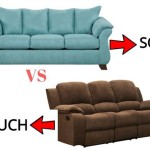How To Distinguish Between Real Leather and Faux Leather Sofas
The aesthetics and durability of a sofa are paramount considerations when furnishing a living space. Leather sofas, in particular, are often viewed as symbols of luxury and longevity. However, the market presents a diverse array of options, including both genuine leather and synthetic alternatives. The ability to distinguish between real leather and faux leather is therefore crucial for informed decision-making and ensuring value for money. This article provides a comprehensive guide to identifying real leather sofas, outlining key characteristics and tests that can be employed to differentiate them from their synthetic counterparts.
Leather, defined as the tanned hide of an animal, possesses inherent qualities that contribute to its desirability. These include natural grain variations, breathability, and a supple texture that evolves over time. Faux leather, conversely, is a manufactured material designed to mimic the appearance and feel of genuine leather. It typically consists of a fabric base coated with a layer of polyvinyl chloride (PVC) or polyurethane (PU). While faux leather has made significant advancements in terms of visual resemblance, it generally lacks the long-term durability and unique aging properties of real leather.
The price point of a sofa often serves as an initial indicator of its composition. Real leather sofas typically command a higher price due to the cost of raw materials, tanning processes, and skilled craftsmanship. However, relying solely on price is not a definitive method, as sophisticated faux leather can also be marketed at a relatively high cost. A more thorough examination of the sofa's physical attributes and construction is necessary for accurate identification.
Examining the Grain and Texture
One of the most reliable indicators of genuine leather is its natural grain pattern. Real leather exhibits a unique and irregular grain, characterized by variations in texture and subtle imperfections. These inconsistencies arise from the natural markings and growth patterns of the animal hide. In contrast, faux leather typically displays a uniform, repeating pattern that is artificially embossed onto the surface. This uniformity can be easily detected upon close inspection, particularly with a magnifying glass.
To assess the grain, carefully examine the surface of the sofa, paying attention to areas where the leather is stretched or curved. Real leather will show subtle wrinkles and creases that follow the natural contours of the grain. Faux leather, on the other hand, tends to maintain a smooth, even surface, with minimal distortion even when stretched. The edges of the sofa cushions and seams also provide valuable clues. Real leather edges often appear slightly rough and unfinished, whereas faux leather edges are typically clean-cut and perfectly sealed.
The texture of the leather is another distinguishing factor. Real leather has a supple, slightly elastic feel. When pressed, it should yield slightly and then return to its original shape. Faux leather, particularly PVC-based versions, often feels stiffer and less pliable. It may also have a slightly plastic or rubbery feel. PU-based faux leather, however, can more closely approximate the feel of real leather, making the texture test less conclusive in some cases.
Furthermore, the breathability of the material can be assessed. Real leather is a porous material that allows air to circulate, helping to regulate temperature and prevent moisture buildup. Faux leather, being non-porous, tends to trap heat and moisture, which can result in a clammy or uncomfortable feel, especially during prolonged periods of sitting. A simple test involves placing your hand on the sofa surface for a few minutes. If the area becomes noticeably warm and damp, it is likely that the sofa is made of faux leather.
The Smell Test and Edge Inspection
The olfactory sense provides another valuable tool for distinguishing between real and faux leather. Real leather possesses a distinctive, natural aroma that is often described as earthy or leathery. This scent is a result of the tanning process and the inherent composition of animal hide. Faux leather, conversely, typically has a synthetic or plastic smell, which can be more pronounced when the material is new. While some faux leather manufacturers attempt to mask the synthetic odor with artificial scents, the underlying smell is often still discernible.
To conduct the smell test, bring your nose close to the sofa surface and inhale deeply. The scent of real leather is generally pleasant and natural, while the scent of faux leather is typically artificial and potentially unpleasant. It is important to note that the intensity of the leather smell can vary depending on the type of leather and the tanning process used. However, the presence of a distinctively synthetic smell is a strong indication that the sofa is not made of real leather.
Careful inspection of the edges and reverse side of the sofa can also reveal valuable information. Real leather pieces are often made of multiple panels or pieces stitched together. The edges of these pieces, if visible, will show the fibrous texture of the leather hide. Faux leather, due to its manufacturing process, will usually have a clean, sealed edge that appears synthetic. The reverse side of real leather is often unfinished and may exhibit a suede-like texture. Faux leather, on the other hand, will have a backing fabric or a smooth, uniform surface.
Examine the seams and stitching of the sofa. Real leather is often thicker and requires stronger stitching. The stitch holes on real leather may be slightly larger and more visible. Also, look for the presence of a lining fabric on the back of the material, which is a strong indication of faux leather. The presence of a manufacturer's tag indicating the material composition can also be helpful, though not always definitive, as mislabeling can occur. Look for terms like "genuine leather", "top-grain leather", or "full-grain leather" to indicate real leather.
The Water Drop Test and Fire Resistance
The water drop test is a simple yet effective method for assessing the porosity and absorbency of the material. Place a small drop of water on the sofa surface and observe how it behaves. Real leather, being porous, will absorb the water relatively quickly, causing it to darken slightly. Faux leather, being non-porous, will repel the water, causing it to bead up on the surface. The water drop test should be performed in an inconspicuous area of the sofa to avoid any potential damage or staining.
To conduct the water drop test, use a clean cloth or dropper to place a small drop of water (about the size of a pea) on the sofa surface. Observe the water droplet for a few minutes. If the water is absorbed within a minute or two and the area becomes slightly darker, it is likely that the sofa is made of real leather. If the water remains beaded up on the surface without being absorbed, it is likely that the sofa is made of faux leather. It is important to note that some treated or coated leathers may exhibit water resistance, but the water absorption will still be noticeable to some degree.
While not recommended due to potential fire hazards, the fire resistance test can also provide an indication of the material's composition. Real leather is naturally fire-resistant and will char or smolder when exposed to a flame, but it will not easily ignite. Faux leather, particularly PVC-based versions, is highly flammable and will melt or burn rapidly, producing a strong, acrid odor. This test should only be performed by trained professionals in a controlled environment, and should never be attempted on a valuable piece of furniture.
A safer, less destructive method to test thermal response is to apply heat from a hair dryer. Real leather will soften and may emit a faint, natural leather smell when heated. Faux leather may become more pliable but will retain its synthetic odor and may even emit fumes if overheated. Always exercise caution and avoid prolonged exposure to heat, which could potentially damage either material.
Ultimately, verifying a sofa's leather composition often necessitates a combination of these methods. Consider the price, examine the grain and texture, conduct the smell test, inspect the edges, and perform the water drop test. By carefully evaluating these aspects, informed decisions can be made regarding the authenticity and quality of the leather sofa.

Leather Vs Leatherette Sofa How To Tell Real Couch

Real Leather Or Faux And How To Tell Them Apart

I Team A Leather Sofa How To Know If It Is Real

How Do You Tell If A Leather Sofa Is Real Chesterfields

Leather Vs Leatherette Sofa How To Tell Real Couch

Deciphering Comfort Air Leather Vs Genuine Sofas Which Is Right For You Direct Furniture Warehouse

Faux Leather Vs Real A Guide To Furniture

Leather Vs Leatherette Sofa How To Tell Real Couch

Fake Vs Real Leather Couches How To Tell The Difference Choice

Leather Vs Leatherette Sofa How To Tell Real Couch








